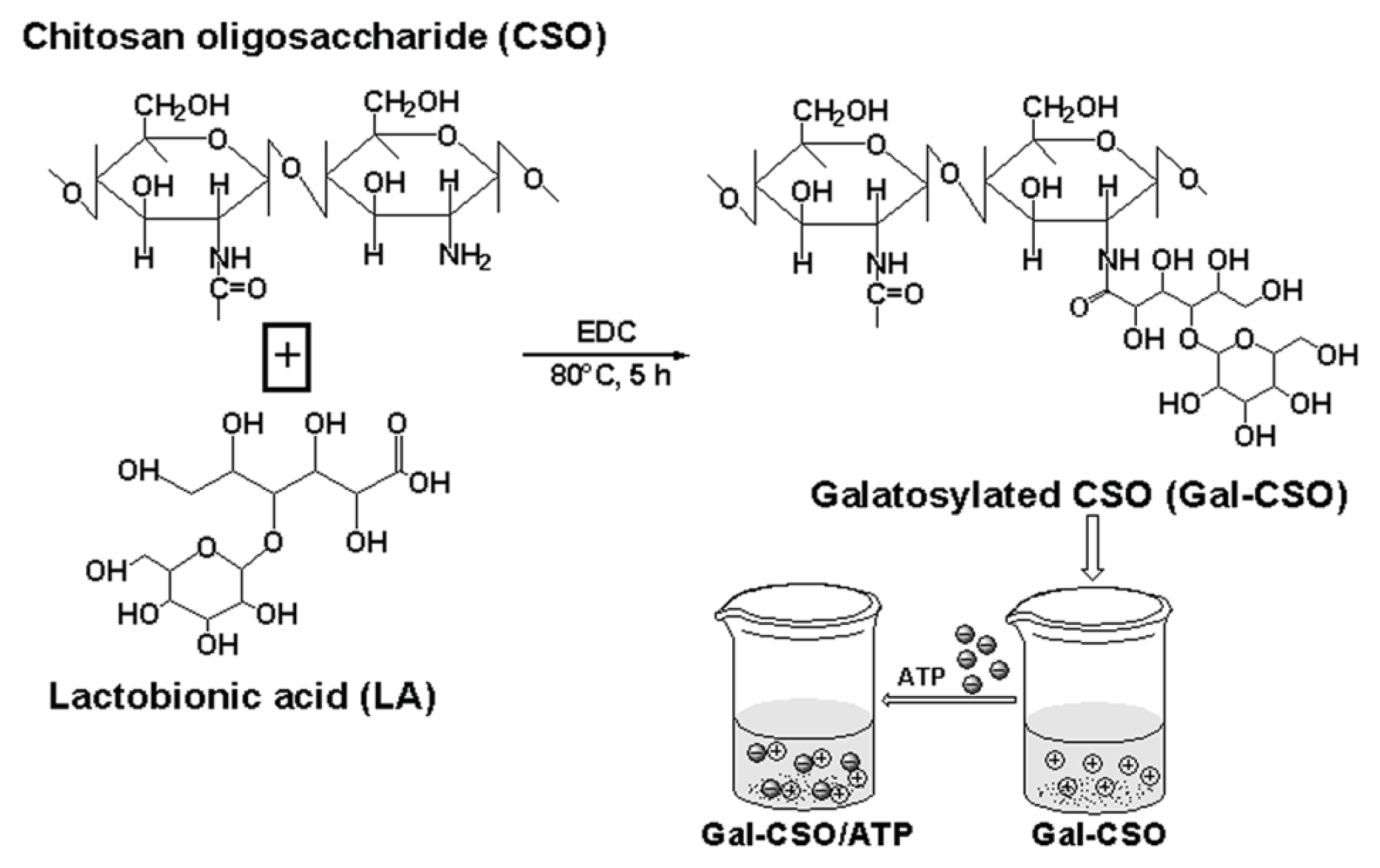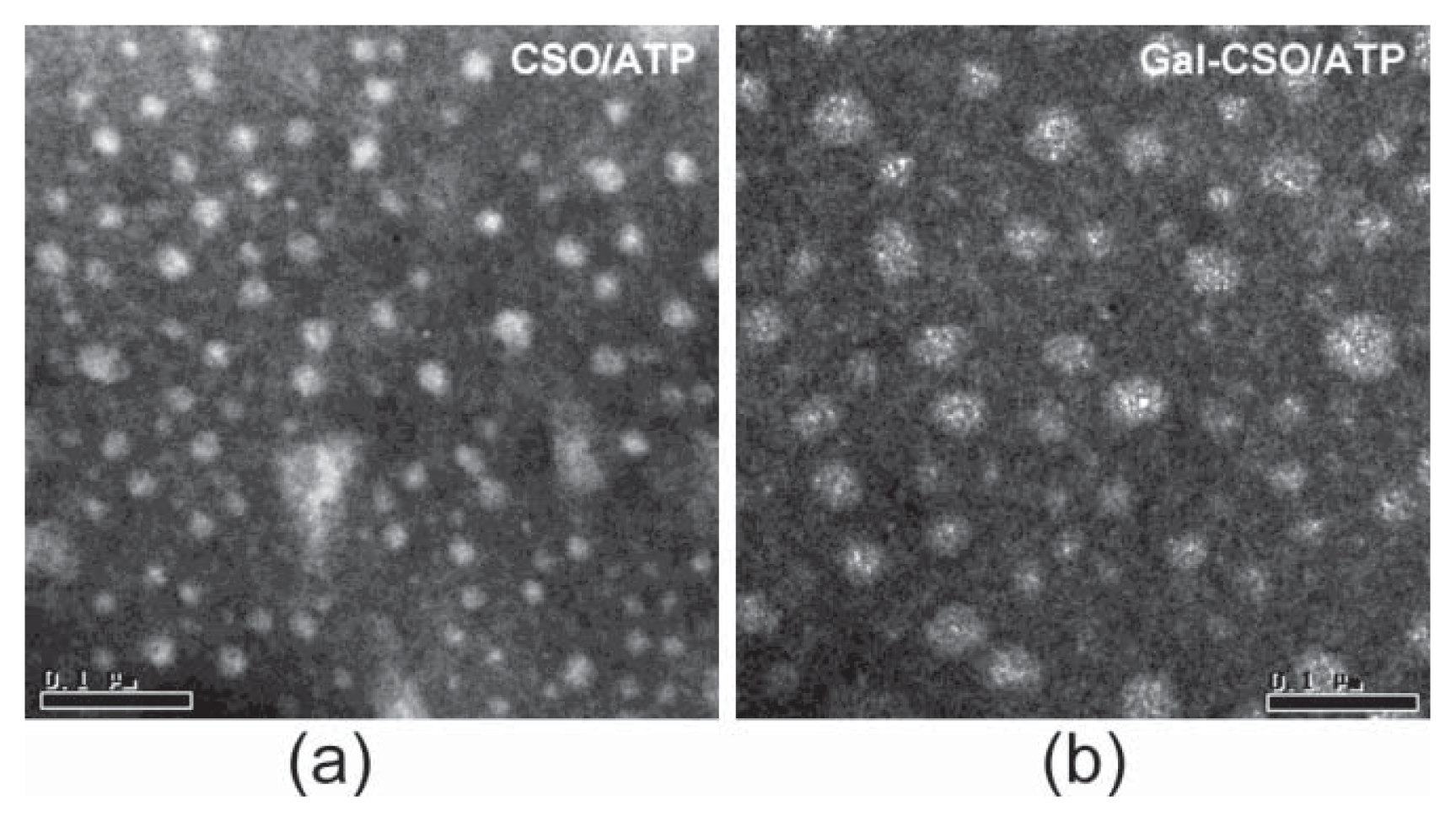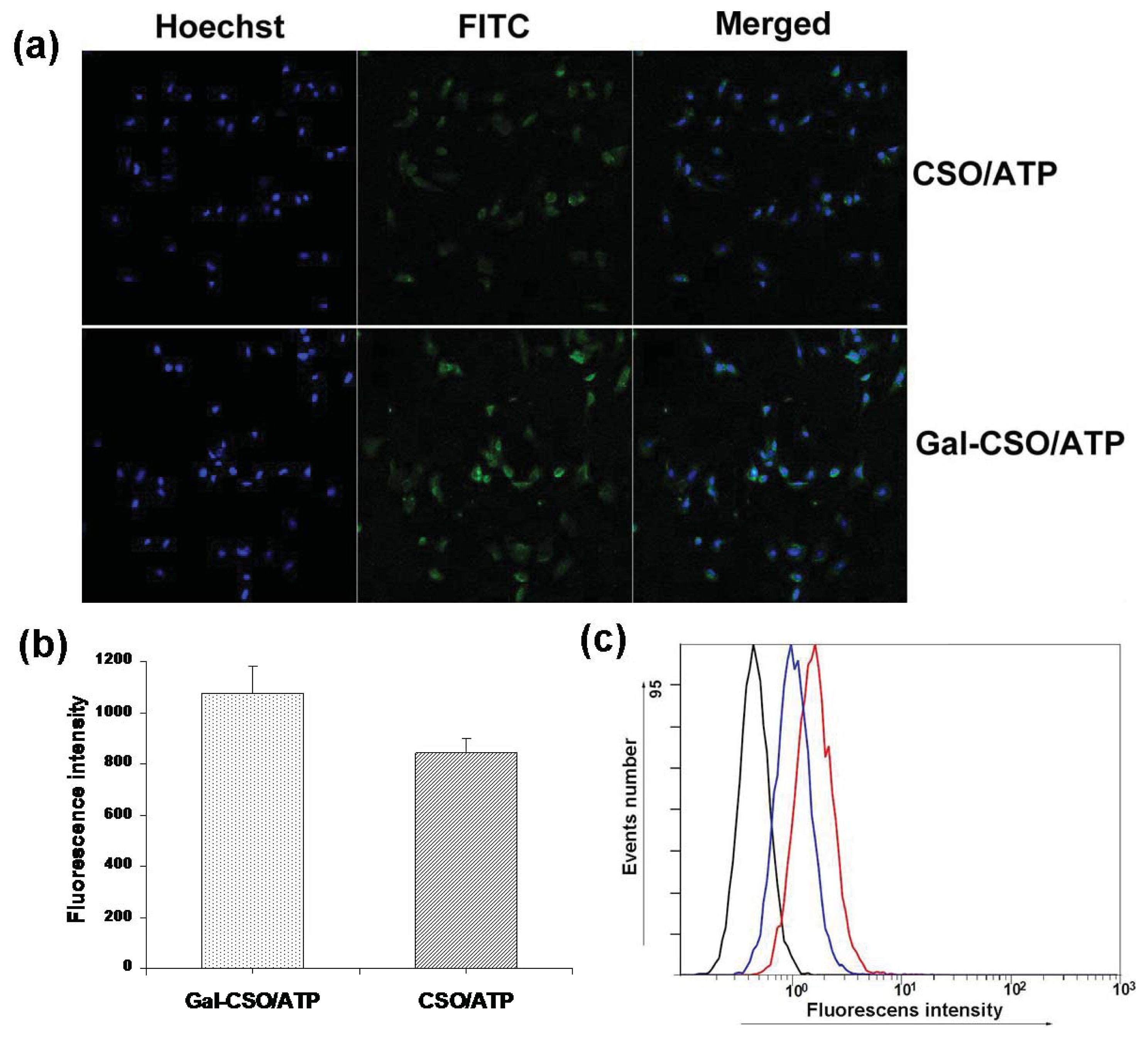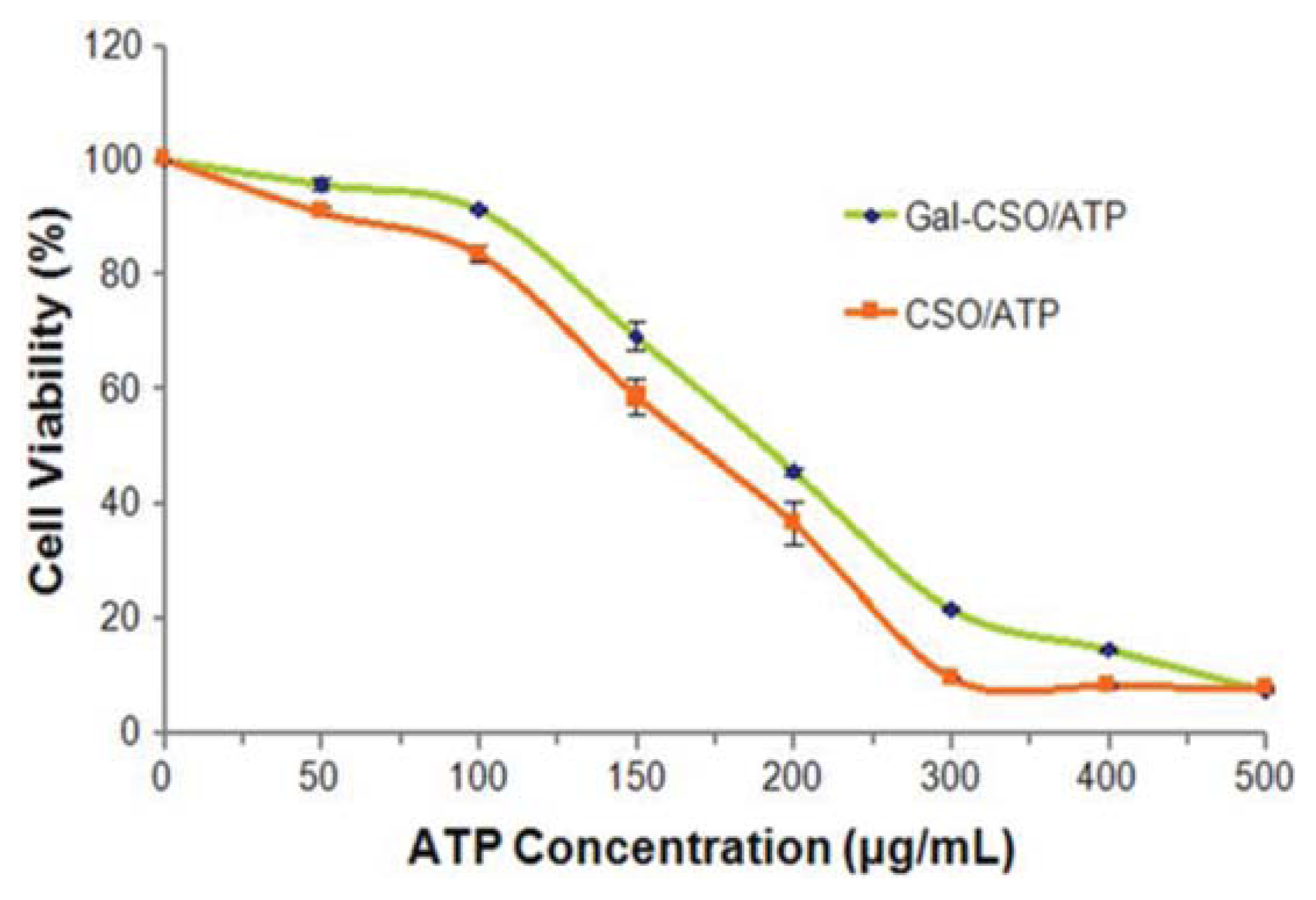Galactosylated Chitosan Oligosaccharide Nanoparticles for Hepatocellular Carcinoma Cell-Targeted Delivery of Adenosine Triphosphate
Abstract
:1. Introduction
2. Results and Discussion
2.1. Preparation of Nanoparticles
2.2. Characteristics of Nanoparticles
2.2.1. Morphology, Particle Size, Zeta Potential and Stability
2.2.2. ATP Loading and in Vitro ATP Release
2.3. In Vitro Cellular Uptake
2.4. In Vitro Cytotoxicity
3. Experimental Section
4. Conclusions
Acknowledgments
Conflict of Interest
References
- Wang, X.; Yang, L.; Chen, Z.G.; Shin, D.M. Application of nanotechnology in cancer therapy and imaging. CA Cancer J. Clin 2008, 58, 97–110. [Google Scholar]
- O’Farrell, N.; Houlton, A.; Horrocks, B.R. Silicon nanoparticles: Applications in cell biology and medicine. Int. J. Nanomed 2006, 1, 451–472. [Google Scholar]
- Torigian, D.A.; Huang, S.S.; Houseni, M.; Alavi, A. Functional imaging of cancer with emphasis on molecular techniques. CA Cancer J. Clin 2007, 57, 206–224. [Google Scholar]
- Bhattacharjee, S.; Ershov, D.; Gucht, J.V.; Alink, G.M.; Rietjens, I.M.; Zuilhof, H.; Marcelis, A.T. Surface charge-specific cytotoxicity and cellular uptake of tri-block copolymer nanoparticles. Nanotoxicology 2013, 7, 71–84. [Google Scholar]
- Irvine, D.J. Drug delivery: One nanoparticle, one kill. Nat. Mater 2011, 10, 342–343. [Google Scholar]
- Mi, F.L.; Wu, Y.Y.; Chiu, Y.L.; Chen, M.C.; Sung, H.W.; Yu, S.H.; Shyu, S.S.; Huang, M.F. Synthesis of a novel glycoconjugated chitosan and preparation of its derived nanoparticles for targeting HepG2 cells. Biomacromolecules 2007, 8, 892–898. [Google Scholar]
- Zhang, J.; Chen, X.G.; Peng, W.B.; Liu, C.S. Uptake of oleoyl-chitosan nanoparticles by A549 cells. Nanomedicine 2008, 4, 208–214. [Google Scholar]
- Wang, Q.; Zhang, L.; Hu, W.; Hu, Z.H.; Bei, Y.Y.; Xu, J.Y.; Wang, W.J.; Zhang, X.N.; Zhang, Q. Norcantharidin-associated galactosylated chitosan nanoparticles for hepatocyte-targeted delivery. Nanomedicine 2010, 6, 371–381. [Google Scholar]
- Shi, L.; Tang, C.; Yin, C. Glycyrrhizin-modified O-carboxymethyl chitosan nanoparticles as drug vehicles targeting hepatocellular carcinoma. Biomaterials 2012, 33, 7594–7604. [Google Scholar]
- Wu, W.; Shen, J.; Banerjee, P.; Zhou, S. Chitosan-based responsive hybrid nanogels for integration of optical pH-sensing, tumor cell imaging and controlled drug delivery. Biomaterials 2010, 31, 8371–8381. [Google Scholar]
- Kean, T.; Thanou, M. Biodegradation, biodistribution and toxicity of chitosan. Adv. Drug. Deliv. Rev 2010, 62, 3–11. [Google Scholar]
- Zhou, X.; Zhang, X.; Yu, X.; Zha, X.; Fu, Q.; Liu, B.; Wang, X.; Chen, Y.; Shan, Y.; Jin, Y.; et al. The effect of conjugation to gold nanoparticles on the ability of low molecular weight chitosan to transfer DNA vaccine. Biomaterials 2008, 29, 111–117. [Google Scholar]
- Arca, H.C.; Gunbeyaz, M.; Senel, S. Chitosan-based systems for the delivery of vaccine antigens. Expert Rev. Vaccines 2009, 8, 937–953. [Google Scholar]
- Ramesan, R.M.; Sharma, C.P. Modification of chitosan nanoparticles for improved gene delivery. Nanomedicine 2012, 7, 5–8. [Google Scholar]
- Shi, B.; Shen, Z.; Zhang, H.; Bi, J.; Dai, S. Exploring N-imidazolyl-O-carboxymethyl chitosan for high performance gene delivery. Biomacromolecules 2012, 13, 146–153. [Google Scholar]
- Malmo, J.; Sorgard, H.; Varum, K.M.; Strand, S.P. siRNA delivery with chitosan nanoparticles: Molecular properties favoring efficient gene silencing. J. Control. Release 2012, 158, 261–268. [Google Scholar] [Green Version]
- Ta, H.T.; Dass, C.R.; Larson, I.; Choong, P.F.; Dunstan, D.E. A chitosan hydrogel delivery system for osteosarcoma gene therapy with pigment epithelium-derived factor combined with chemotherapy. Biomaterials 2009, 30, 4815–4823. [Google Scholar]
- Park, J.S.; Na, K.; Woo, D.G.; Yang, H.N.; Kim, J.M.; Kim, J.H.; Chung, H.M.; Park, K.H. Non-viral gene delivery of DNA polyplexed with nanoparticles transfected into human mesenchymal stem cells. Biomaterials 2010, 31, 124–132. [Google Scholar]
- Ditto, A.J.; Shah, P.N.; Yun, Y.H. Non-viral gene delivery using nanoparticles. Expert Opin. Drug Deliv 2009, 6, 1149–1160. [Google Scholar]
- Song, B.; Zhang, W.; Peng, R.; Huang, J.; Nie, T.; Li, Y.; Jiang, Q.; Gao, R. Synthesis and cell activity of novel galactosylated chitosan as a gene carrier. Colloids Surf. B Biointerfaces 2009, 70, 181–186. [Google Scholar]
- Kim, J.H.; Minai-Tehrani, A.; Kim, Y.K.; Shin, J.Y.; Hong, S.H.; Kim, H.J.; Lee, H.D.; Chang, S.H.; Yu, K.N.; Bang, Y.B.; et al. Suppression of tumor growth in H-ras12V liver cancer mice by delivery of programmed cell death protein 4 using galactosylated poly(ethylene glycol)-chitosan-graft-spermine. Biomaterials 2012, 33, 1894–1902. [Google Scholar]
- Zhou, X.; Zhang, M.; Yung, B.; Li, H.; Zhou, C.; Lee, L.J.; Lee, R.J. Lactosylated liposomes for targeted delivery of doxorubicin to hepatocellular carcinoma. Int. J. Nanomedicine 2012, 7, 5465–5474. [Google Scholar]
- Cheng, M.; Han, J.; Li, Q.; He, B.; Zha, B.; Wu, J.; Zhou, R.; Ye, T.; Wang, W.; Xu, H.; et al. Synthesis of galactosylated chitosan/5-fluorouracil nanoparticles and its characteristics, in vitro and in vivo release studies. J. Biomed. Mater. Res. B Appl. Biomater 2012, 100, 2035–2043. [Google Scholar]
- Kang, Y.; Wang, C.; Liu, K.; Wang, Z.; Zhang, X. Enzyme-responsive polymeric supra-amphiphiles formed by the complexation of chitosan and ATP. Langmuir 2012, 28, 14562–14566. [Google Scholar]
- Corbin, I.R.; Buist, R.; Volotovskyy, V.; Peeling, J.; Zhang, M.; Minuk, G.Y. Regenerative activity and liver function following partial hepatectomy in the rat using 31P-MR spectroscopy. Hepatology 2002, 36, 345–353. [Google Scholar]
- Corbin, I.R.; Buist, R.; Peeling, J.; Zhang, M.; Uhanova, J.; Minuk, G.Y. Hepatic 31P MRS in rat models of chronic liver disease: Assessing the extent and progression of disease. Gut 2003, 52, 1046–1053. [Google Scholar]
- Zhang, Z.; Li, J.; Wu, S.; Liu, Y.; Fan, Z.; Zhou, X.; Zhao, H.; Li, D.; Huan, Y. Cine-MRI and 31P-MRS for evaluation of myocardial energy metabolism and function following coronary artery bypass graft. Magn. Reson. Imaging 2010, 28, 936–942. [Google Scholar]
- Corbin, I.R.; Ryner, L.N.; Singh, H.; Minuk, G.Y. Quantitative hepatic phosphorus-31 magnetic resonance spectroscopy in compensated and decompensated cirrhosis. Am. J. Physiol. Gastrointest. Liver Physiol 2004, 287, G379–G384. [Google Scholar]
- Chung, T.W.; Yang, J.; Akaike, T.; Cho, K.Y.; Nah, J.W.; Kim, S.I.; Cho, C.S. Preparation of alginate/galactosylated chitosan scaffold for hepatocyte attachment. Biomaterials 2002, 23, 2827–2834. [Google Scholar]
- Kamruzzaman Selim, K.M.; Ha, Y.S.; Kim, S.J.; Chang, Y.; Kim, T.J.; Ho Lee, G.; Kang, I.K. Surface modification of magnetite nanoparticles using lactobionic acid and their interaction with hepatocytes. Biomaterials 2007, 28, 710–716. [Google Scholar]
- Park, I.K.; Yang, J.; Jeong, H.J.; Bom, H.S.; Harada, I.; Akaike, T.; Kim, S.I.; Cho, C.S. Galactosylated chitosan as a synthetic extracellular matrix for hepatocytes attachment. Biomaterials 2003, 24, 2331–2337. [Google Scholar]
- Jiang, H.L.; Kwon, J.T.; Kim, E.M.; Kin, Y.K.; Arote, R.; Jere, D.; Jeong, H.J.; Jang, M.K.; Nah, J.W.; Xu, C.X.; et al. Galactosylated poly(ethylene glycol)-chitosan-graft-polyethylenimine as a gene carrier for hepatocyte-targeting. J. Control. Release 2008, 131, 150–157. [Google Scholar]
- Kim, E.M.; Jeong, H.J.; Park, I.K.; Cho, C.S.; Moon, H.B.; Yu, D.Y.; Bom, H.S.; Sohn, M.H.; Oh, I.J. Asialoglycoprotein receptor targeted gene delivery using galactosylated polyethylenimine-graft-poly(ethylene glycol): In vitro and in vivo studies. J. Control. Release 2005, 108, 557–567. [Google Scholar]
- Wei, W.; Yue, Z.G.; Qu, J.B.; Yue, H.; Su, Z.G.; Ma, G.H. Galactosylated nanocrystallites of insoluble anticancer drug for liver-targeting therapy: An in vitro evaluation. Nanomedicine 2010, 5, 589–596. [Google Scholar]
- Jiang, H.L.; Kwon, J.T.; Kim, Y.K.; Kim, E.M.; Arote, R.; Jeong, H.J.; Nah, J.W.; Choi, Y.J.; Akaike, T.; Cho, M.H.; et al. Galactosylated chitosan-graft-polyethylenimine as a gene carrier for hepatocyte targeting. Gene. Ther 2007, 14, 1389–1398. [Google Scholar]
- Hu, F.Q.; Zhao, M.D.; Yuan, H.; You, J.; Du, Y.Z.; Zeng, S. A novel chitosan oligosaccharide-stearic acid micelles for gene delivery: Properties and in vitro transfection studies. Int. J. Pharm 2006, 315, 158–166. [Google Scholar]
- Fischer, D.; Li, Y.; Ahlemeyer, B.; Krieglstein, J.; Kissel, T. In vitro cytotoxicity testing of polycations: Influence of polymer structure on cell viability and hemolysis. Biomaterials 2003, 24, 1121–1131. [Google Scholar]






| Sample | Particle size (nm) | Zeta potential (mV) | DL (%) | EE (%) |
|---|---|---|---|---|
| CSO/ATP | 37.73 ± 1.27 | 43.58 ± 3.21 | 23.91 ± 0.1 | 78.58 ± 0.6 |
| Gal-CSO/ATP | 51.03 ± 3.26 | 30.50 ± 1.25 | 26.25 ± 0.1 | 88.98 ± 0.5 |
© 2013 by the authors; licensee MDPI, Basel, Switzerland This article is an open access article distributed under the terms and conditions of the Creative Commons Attribution license (http://creativecommons.org/licenses/by/3.0/).
Share and Cite
Zhu, X.L.; Du, Y.Z.; Yu, R.S.; Liu, P.; Shi, D.; Chen, Y.; Wang, Y.; Huang, F.F. Galactosylated Chitosan Oligosaccharide Nanoparticles for Hepatocellular Carcinoma Cell-Targeted Delivery of Adenosine Triphosphate. Int. J. Mol. Sci. 2013, 14, 15755-15766. https://doi.org/10.3390/ijms140815755
Zhu XL, Du YZ, Yu RS, Liu P, Shi D, Chen Y, Wang Y, Huang FF. Galactosylated Chitosan Oligosaccharide Nanoparticles for Hepatocellular Carcinoma Cell-Targeted Delivery of Adenosine Triphosphate. International Journal of Molecular Sciences. 2013; 14(8):15755-15766. https://doi.org/10.3390/ijms140815755
Chicago/Turabian StyleZhu, Xiu Liang, Yong Zhong Du, Ri Sheng Yu, Ping Liu, Dan Shi, Ying Chen, Ying Wang, and Fang Fang Huang. 2013. "Galactosylated Chitosan Oligosaccharide Nanoparticles for Hepatocellular Carcinoma Cell-Targeted Delivery of Adenosine Triphosphate" International Journal of Molecular Sciences 14, no. 8: 15755-15766. https://doi.org/10.3390/ijms140815755




